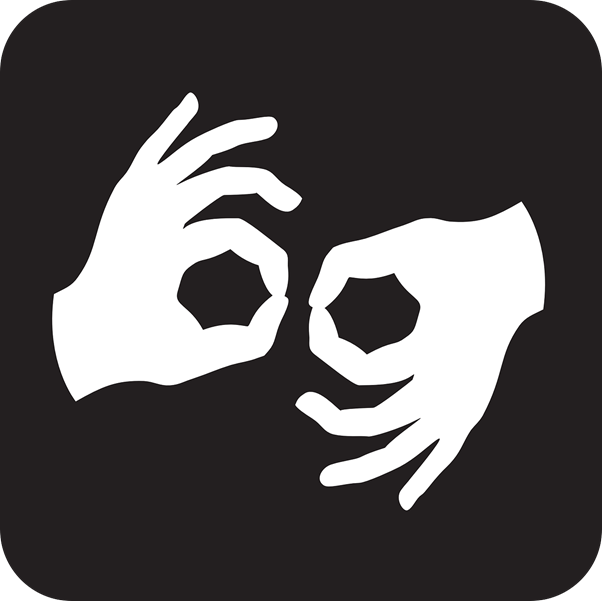What Is ASL Interpreting?
A Complete Guide for Beginners
Table of Contents
Welcome to Our Comprehensive Guide on ASL Interpreting!

Introduction
This comprehensive guide is meant to answer the question: “What is ASL interpreting?”
Whether you’re new to the concept or seeking to deepen your understanding, this article will provide valuable insights into American Sign Language (ASL) interpreting.
By the end, you’ll know the importance, types, and role of ASL interpreters and why hiring experienced professionals is crucial for businesses, educational institutions, and beyond.
So, What is ASL Interpreting?
ASL interpreting involves converting spoken language into American Sign Language and vice versa.
This complex system of hand, finger, arm, head and facial expressive gestures allows deaf and hard-of-hearing individuals to communicate effectively with one another and with hearing people.
ASL interpreters must have fluency in both ASL and English and a deep understanding of cultural nuances to ensure accurate communication.
Understanding American Sign Language (ASL)
American Sign Language is a visual language used by the Deaf community in the United States and anglophone parts of Canada. ASL has its own grammar and syntax, distinct from English. It uses hand shapes, facial expressions, and body movements to convey meaning.
Historical Context of ASL
ASL has a rich history dating back to the early 19th century. Influences include French Sign Language (LSF) and the signing systems used by deaf communities in the U.S.
The establishment of the first American school for the Deaf in 1817 by Thomas Gallaudet played a crucial role in the development of ASL as a recognized language.
ASL includes influences from household signing systems, different local sign languages and Old French Sign Language.
Read about Gallaudet University here.
The Importance of ASL
ASL is more than just a communication tool; it is a vital part of Deaf culture and identity. It fosters community, facilitates education, and ensures access to information. For businesses and organizations, using ASL interpreters enhances inclusivity and compliance with accessibility laws and regulations such as the Americans with Disabilities Act.

Different Types of Relevant Sign Language
There are several forms of sign language relevant to ASL users, including:
- Pidgin Signed English (PSE): A combination of ASL and English.
- Signed Exact English (SEE): A system that uses English grammar and syntax.
- Tactile Signing: Used by individuals who are deaf-blind, involving touch.
- Gestuno: also known as International Sign (IS), is a streamlined version of signing meant to be understandable to individuals across borders. It is a pidgin-like sign language developed to facilitate communication between deaf individuals from different linguistic backgrounds, primarily used at international deaf events and conferences.
- Contact Sign: is a hybrid form of communication that emerges when Deaf signers and hearing non-signers use elements of both a natural sign language and the surrounding spoken language to facilitate understanding.
- ASL Slang: Like any language, ASL contains slang expressions that not everyone understands. These phrases can evolve and frequently originate within particular social or cultural groupings.
- Regional Variations: ASL is subject to regional variations, much like spoken languages have dialects. There may be vocabulary, grammar, and sign variations among American regions. For instance, the ASL spoken in the Northeast and the South may differ.
The Role of ASL Interpreters
ASL interpreters bridge the communication gap between hearing and deaf individuals. They work in various settings, including:
- Educational: Schools and universities.
- Medical: Hospitals and clinics.
- Legal: Courtrooms and law offices.
- Corporate: Business meetings and conferences.
- Entertainment: Theater and film production.
Some common types of ASL Interpreters are:
- Agency Interpreters: These interpreters work for agencies which make various tasks and assignments easier for those in need of ASL interpreting, such as scheduling service, enabling and setting up remote interpreting, and ensuring specialized interpreting talent is consistently available at the time and place needed. The duties of an agency interpreter might vary greatly depending on the agency and the interpreter’s qualifications.
- Freelance Interpreters: These interpreters either secure their clients/work assignments or have contracts with multiple interpreting agencies. Various establishments may employ a freelance interpreter on an as-needed basis.

Differences Between Translators & Interpreters
While both translators and interpreters convert languages, their roles differ:
- Translators: Work with written text.
- Interpreters: Convert spoken or signed language in real-time.
Understanding RID (Registry of Interpreters for the Deaf)
The Registry of Interpreters for the Deaf (RID) is a professional organization that sets standards for ASL interpreters. RID certification ensures that interpreters meet high ethical and professional standards, providing confidence in their skills and reliability.
The RID is, among other things, a registry for interpreters for the Deaf that takes the lead in promoting excellence among transliterators and ASL interpreters. By working together with the Deaf community, the RID promotes the advancement of the ASL interpreters’ profession and maintains a national standard for certified transliterators and sign language interpreters, providing continual professional development opportunities, and upholding a widely accepted code of ethics.
Resources for Learning ASL
Learning ASL can be a rewarding experience. Here are some resources:
- Online Courses: Websites like ASL University and SignSchool.
- Local Classes: Community colleges and Deaf organizations.
- Apps: Mobile apps like SignSchool and The ASL App.
This ability ensures that all voices are accurately captured, maintaining the integrity of discussions and meetings.

There are also many online tools for learning American Sign Language including:
- ASLPro.com: This website provides a wealth of information for learning American Sign Language, such as movies showing signs in context and a dictionary with thousands of signs.
- LifePrint: Dr. Bill Vicars’ extensive resource meant to assist students in practicing creating sentences in ASL by offering courses, videos, a lexicon, and a sentence structure generator.
- HandSpeak: Offers thousands of signs in an ASL lexicon, articles, educational materials, and details on Deaf culture.
- Signing Savvy: is an online sign language dictionary that offers hundreds of high-definition videos of fingerspelled words, ASL signals, and other frequently used signs in the US and Canada.
We neither endorse nor exclusively support any of the websites referenced above. We do not confirm the accuracy of these sources and encourage independent research into available tools beyond the abovementioned list.
Accessibility and Inclusion Through ASL
Using ASL interpreters promotes accessibility and inclusion, ensuring that deaf and hard-of-hearing individuals have equal opportunities to participate in various activities. This practice is essential for compliance with the Americans with Disabilities Act (ADA) and other accessibility laws.
With professional American Sign Language interpreting, deaf and hard-of-hearing individuals can access a wide range of services, such as staff meetings, educational opportunities, and medical appointments. This inclusion creates environments where people who are deaf can engage fully and actively in society.
More organizations are now incorporating ASL interpreters in their events to reach a larger audience. ASL interpreters can be seen at concerts, comedy shows, live interviews, and debates. This inclusion allows the Deaf Community to enjoy conversations and social events without feeling disengaged or burdensome to their friends and family.
The increased use of ASL interpreters in public settings has significantly improved access for the DHOH Community, allowing them to experience real-time events with the same enthusiasm and engagement as hearing individuals. Although this is a significant achievement compared to decades ago, there is still room for improvement.

Legal Compliance and ASL
According to the ADA, businesses and educational institutions are not required to hire ASL interpreters if a notebook and pen can effectively communicate the necessary information. However, if the information exchange is lengthy or complex, a competent interpreter may be required. It is essential for both the individual with the disability and the company or school to consult with professionals to determine which accommodation or service will best facilitate effective communication.
By understanding and implementing these practices, organizations can ensure they meet legal requirements and provide an inclusive environment for everyone.
The Hiring Process for ASL Interpreters
Hiring an ASL interpreter is a big responsibility for organizations because the person in charge of securing a reasonable accommodation will be responsible for accurate, precise, and effective communication to members of the deaf community. Such needs and requests often arise at the last minute, causing tension when an organization is unprepared.
Therefore, the requirements and preferences of the deaf person should be the first consideration for institutions when hiring an interpreter, among many other considerations.
The person who is deaf should take the lead in the conversation on interpreting accommodations, and whenever feasible, their wishes should be respected.
Using an agency to hire qualified American Sign Language Interpreting services significantly minimizes the hassle of looking for, vetting and scheduling a freelance interpreter on your own. Leaning on an experienced and well-respected agency ensures your institution will find specialized and certified interpreters matching your situation and preferences.
When hiring ASL interpreters, consider the following:
- Certification: Ensure they are RID certified or hold equivalent state certification.
- Experience: Look for interpreters with experience in your specific industry.
- Reputation: Check reviews and references of your selected interpreters or agency.
- Compliance: Ensure and ASL interpreter is the most complete, efficient and appropriate accommodation your institution needs to maintain compliance with the ADA and other relevant laws.

Conclusion
ASL interpreting is a crucial service that enhances communication, accessibility, and inclusion for the Deaf and Hard-of-Hearing Community. By understanding its importance and hiring qualified interpreters, businesses and organizations can create more inclusive environments and remain compliant.
FAQ
Q: What is ASL interpreting?
A: ASL interpreting involves converting spoken language into American Sign Language and vice versa to facilitate communication for Deaf and Hard-of-Hearing individuals.
Q: Why is ASL important?
A: ASL is vital for fostering community, facilitating education, and ensuring access to information for the Deaf Community.
Q: How do I hire an ASL interpreter?
A: Look for certified interpreters with years of experience in your specific industry and check their reputation over time. Then agree upon industry standard rates and schedule their availability. In case of remote interpreting be sure to provide secure links to all involved. Alternatively, contact a well-respected agency such as Karasch.com and get scheduling confirmation within minutes.
Q: What is the difference between ASL and deaf interpreters (or CDI)?
A: ASL interpreters facilitate communication between spoken English and ASL, while a CDI ensures that the interpretation aligns with the cultural and contextual nuances relevant to the Deaf individual. Learn more about relevant terms in our Accessibility Services Glossary.
Take Action!
Are you ready to make your events and communications more inclusive?
Contact Karasch.com to schedule professional American Sign Language interpreting services easily and get scheduling confirmation within minutes.
Our Latest Resources
Request A
Call Back
Request A Call Back
Do you have additional questions?
Click here to meet your dedicated Client Relationship Manager.


